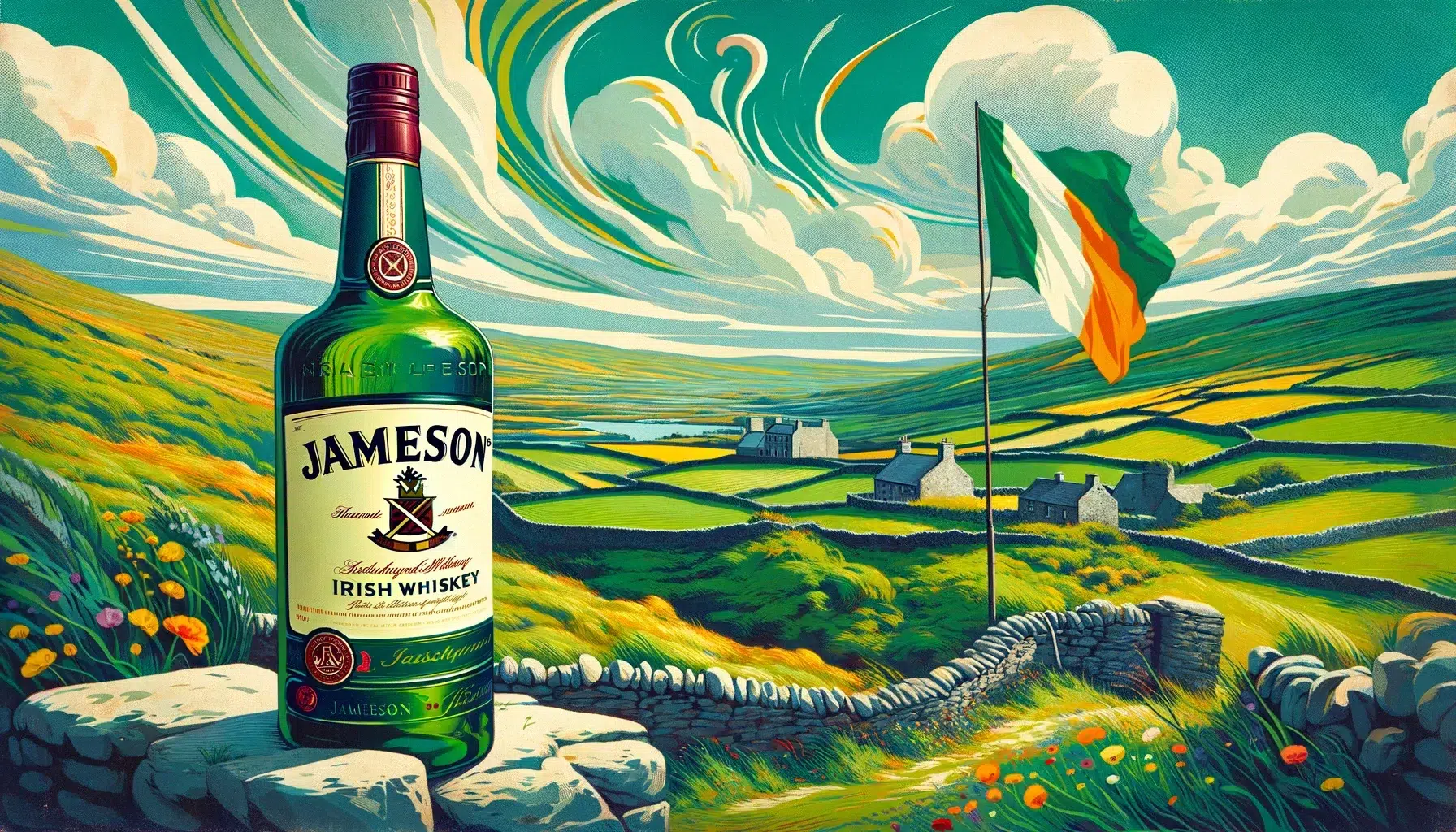Irish whiskey is often seen as the lesser-known little brother of its Scottish and American counterparts. However, it carves its niche with unparalleled smoothness and approachability.
This unique character sets it apart in the vast world of whiskies, offering a distinct experience that distinguishes Irish whiskey as a category in its own right. Key varieties of Irish whiskey include Single Malt, Single Pot Still, and Blended Whiskeys, each known for their distinct flavors. Single Grain Irish whiskey also stands out, offering a lighter but complex choice for whiskey lovers.
Diving deeper, each type of Irish whiskey presents its own set of flavors, production techniques, historical significance, and recommendations for food pairings. The following sections will explore these aspects in detail, providing a richer understanding of what makes Irish whiskey a cherished spirit worldwide.
Types of Irish Whiskey
Irish whiskey branches into four distinct types, each marked by its own flavor characteristics and production methods.
| Type of Irish Whiskey | Description | Example Brands/Expressions |
|---|---|---|
| Single Malt Irish Whiskey | Crafted solely from 100% malted barley and distilled in pot stills, known for its richness and complexity. | – Bushmills 10 Year Single Malt – Teeling Single Malt – Knappogue Castle 12 Year Single Malt |
| Single Pot Still Irish Whiskey | Made from a mix of malted and unmalted barley, distilled in a pot still, offering a creamy texture and spicy flavor. | – Redbreast 12 Year – Green Spot – Powers John’s Lane Release |
| Single Grain Irish Whiskey | Produced from grains other than barley, such as corn or wheat, resulting in a lighter and more delicate taste. | – Teeling Single Grain – Kilbeggan Single Grain – Glendalough Double Barrel Single Grain |
| Blended Irish Whiskey | Combines two or more whiskey types, balancing their characteristics to create a harmonious and versatile flavor. | – Jameson Irish Whiskey – Tullamore D.E.W. Original – Bushmills Black Bush |
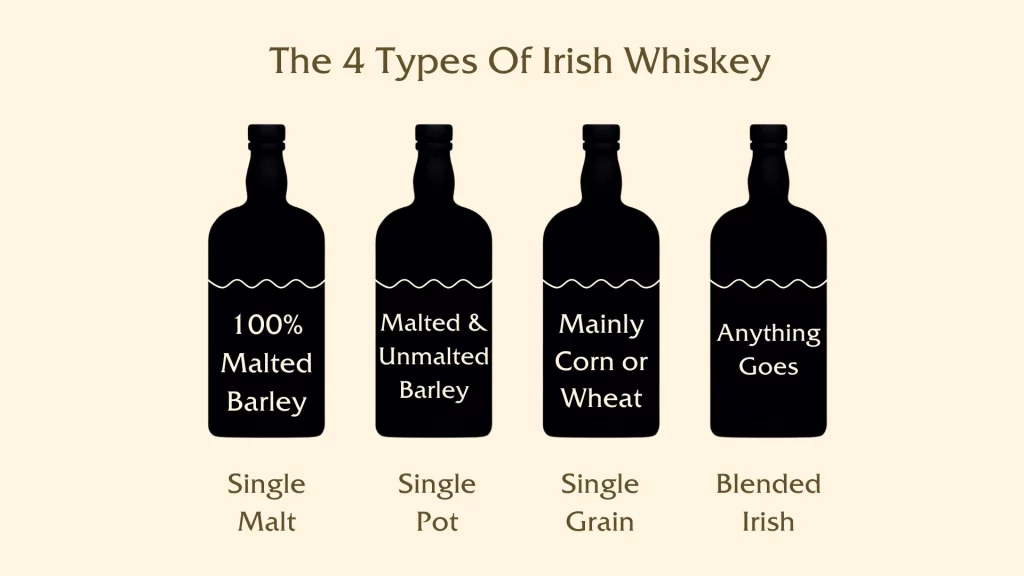
Distinct Characteristics of Irish Whiskey
Irish Whiskey stands out for its remarkable smoothness and distinctive taste, achieved through triple distillation and the use of unpeated malt. This results in a purer, smoother spirit that’s lighter and approachable for just about anyone.
Triple Distillation for Smoothness
Triple distillation is pivotal in crafting the smoothness synonymous with Irish whiskey. This method, involving three rounds of distillation, meticulously removes impurities, yielding a spirit that is exceptionally pure and velvety. This process is integral to providing a clean, refined taste that is both inviting and enjoyable, especially for those exploring whiskey for the first time.
Learn more about the distillation in our article on the whiskey distillation process.
Unpeated Malt for a Lighter Flavor
The choice of unpeated malt is crucial in defining the lighter flavor profile of Irish whiskey. Steering clear of the smoky characteristics imparted by peated malt, Irish whiskey opts for unpeated malt, ensuring a brighter, more accessible taste. This results in a whiskey that is refreshingly light, emphasizing the grain’s natural flavors and allowing the subtle nuances of the whiskey to emerge more prominently.
Learn more about the full process in our article on the whiskey production process.
The Rich Flavor Spectrum of Irish Whiskey
Irish Whiskey is one of the most versatile types of whiskey from any country. It offers a flavor range from light and floral to rich and robust, influenced by grain choice, distillation, and aging. Common notes include green apple, vanilla, and caramel.
Triple distillation ensures smoothness, while aging adds complexity with oak, spice, and fruit flavors. This diversity celebrates Ireland’s whiskey-making heritage, appealing to a wide array of tastes
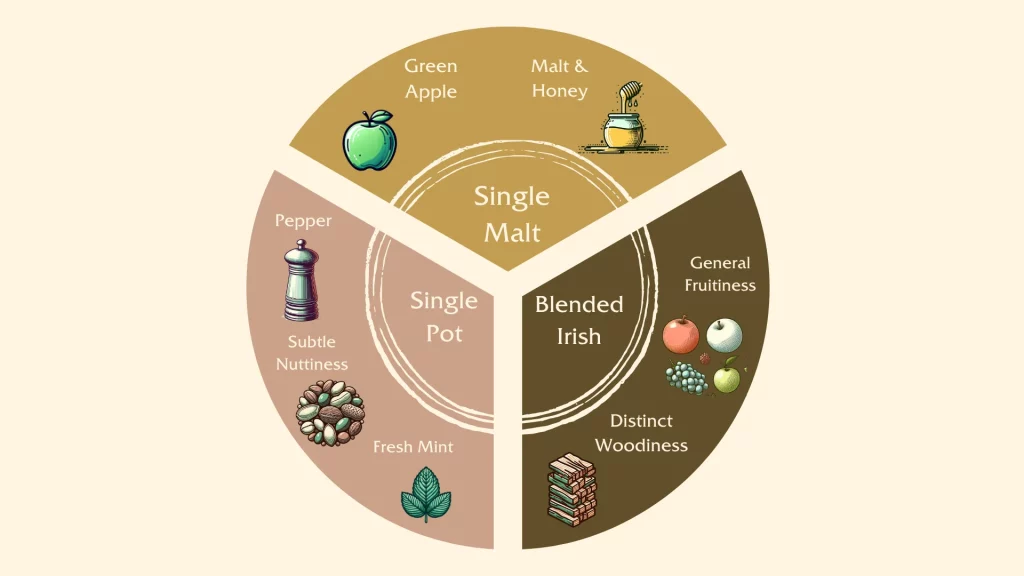
Signature Flavor Notes in Irish Whiskey
Irish Whiskey captivates with its signature flavor notes of green apple, vanilla, and caramel. These core flavors, resulting from meticulous ingredient selection and distillation, create a uniquely inviting taste profile. This distinctive combination renders Irish Whiskey a favored choice among both connoisseurs and casual enthusiasts.
Influence of Grain Bill on Flavor
The flavor of Irish Whiskey is deeply influenced by its grain bill, the blend of grains used in its production. Whether it’s barley, corn, or wheat, each grain contributes its own unique flavor characteristics, ranging from light and floral to rich and creamy. This variation underlines the wide-ranging taste experiences Irish Whiskey offers, highlighting its versatility.
The Role of Aging in Flavor Development
Aging plays a pivotal role in the flavor evolution of Irish Whiskey. As the whiskey matures in wooden casks, it absorbs and integrates complex notes of oak, spice, and fruitiness, enriching its flavor profile. The length of aging and the conditions under which it occurs further refine the whiskey, endowing it with a rich character and unparalleled depth.
Pairing Irish Whiskey with Food
With its diverse flavor spectrum, ranging from light and floral to rich and robust, Irish Whiskey can complement a wide array of culinary experiences. Recognizing the whiskey’s flavor profile is crucial for crafting ideal pairings that delight the senses and enrich any meal.
| Irish Whiskey Type | Food Pairing Suggestions |
|---|---|
| Single Malt Irish Whiskey | – Grilled Salmon: The whiskey’s fruity notes complement the richness of the salmon. – Dark Chocolate Desserts: The depth and complexity of the whiskey enhance the bitter-sweet chocolate flavors. |
| Single Pot Still Irish Whiskey | – Roast Pork with Herbs: The whiskey’s spicy and full-bodied character pairs well with the savory and herbal notes of the pork. – Aged Cheddar Cheese: The creamy texture and spicy flavor of the whiskey match the sharpness of aged cheddar. |
| Single Grain Irish Whiskey | – Sushi and Light Seafood: The whiskey’s lighter and more delicate taste complements the subtlety of seafood. – Fruit Tarts: The smooth and versatile nature of the whiskey pairs nicely with the sweetness and acidity of fruit-based desserts. |
| Blended Irish Whiskey | – Steak and Grilled Meats: The harmonious blend of flavors in the whiskey complements the richness of red meats. – Caramel-based Desserts: The smooth and versatile character of the whiskey enhances the sweetness of caramel desserts. |
Which Irish Whiskey Should You Try First?
Selecting your initial foray into Irish Whiskey hinges on personal taste and the flavor profiles you find appealing. If you’re looking for some new items to add to your whiskey collection, here are specific recommendations to help guide your choice:
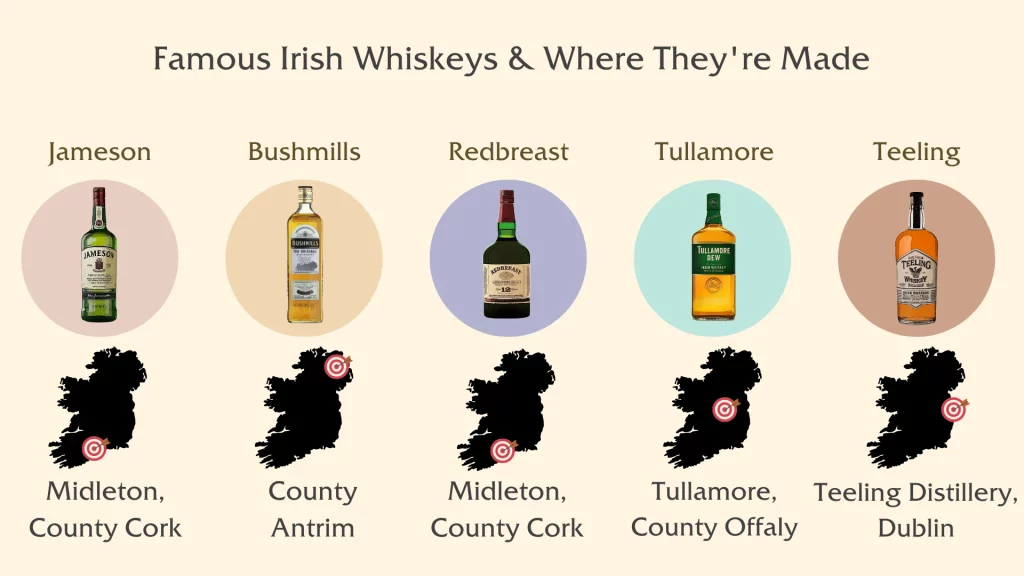
For Those Seeking Gentle, Smooth Flavors
If you’re drawn to gentle, smooth flavors, consider starting with a Single Grain or a light Blended Irish Whiskey. These whiskeys are known for their softness and approachability, providing a subtle complexity that’s accessible even to those new to the world of whiskey.
- Single Grain Irish Whiskey Recommendation: Teeling Single Grain. This whiskey is known for its smooth, sweet profile with hints of spice, making it an excellent introduction to the category.
- Light Blended Irish Whiskey Recommendation: Jameson Irish Whiskey. As a classic example of Irish Whiskey, Jameson offers a balanced flavor with notes of nuts, vanilla, and a touch of sweetness, ideal for newcomers.
For Enthusiasts of Bold, Spicy Notes
Those with a preference for bold and spicy flavors should explore Single Pot Still Irish Whiskey. This category is celebrated for its rich and full-bodied character, delivering a complex blend of spicy, woody, and occasionally fruity notes.
- Single Pot Still Irish Whiskey Recommendation: Redbreast 12 Year Old. Redbreast is a quintessential Single Pot Still Irish Whiskey, offering a rich, spicy, and fruity profile with a creamy mouthfeel.
For Lovers of Sweet, Rich Profiles
If you’re an aficionado of sweet, rich profiles, Single Malt Irish Whiskey might be the most enticing option. Known for its deep, flavor-packed character, Single Malt often features notes of caramel, vanilla, and fruit.
- Single Malt Irish Whiskey Recommendation: Bushmills 10 Year Old Single Malt. This whiskey showcases the depth and complexity of Single Malt Irish Whiskey, with a smooth finish and flavors of honey, fruit, and chocolate.
Regulation Requirements Of Irish Whiskey
The regulations surrounding Irish Whiskey production have a profound impact on the spirit’s quality and characteristics. Here are some examples that illustrate this effect:
- Triple Distillation Requirement: The triple distillation process, a hallmark of many Irish Whiskeys, contributes significantly to the smoothness and purity of the spirit. For instance, Redbreast 12 Year Old, a renowned Single Pot Still Irish Whiskey, benefits from this meticulous distillation process, offering a rich, smooth, and complex flavor profile that is highly appreciated by whiskey enthusiasts.
- Aging in Wooden Casks: The requirement for Irish Whiskey to be aged in wooden casks for at least three years contributes to its depth of flavor and complexity. Teeling Single Grain, aged in Californian red wine barrels, showcases how this regulation influences the whiskey’s character, imparting unique fruity and floral notes alongside a smooth finish.
- Use of Unpeated Malt: The preference for using unpeated malt in Irish Whiskey production results in a lighter and more approachable flavor profile, distinguishing it from its peated counterparts. Bushmills 10 Year Old Single Malt exemplifies the impact of this choice, offering a delicate balance of fruity, spicy, and malty flavors, making it an excellent introduction to Irish Whiskey for newcomers.
History of Irish Whiskey
The history of Irish Whiskey weaves through centuries, with its origins dating back to the 12th century. It’s believed that the art of distillation was brought to Ireland by monks, initially used for medicinal purposes, and gradually evolved into whiskey production. Irish Whiskey enjoyed a golden age, becoming a cherished part of Irish heritage and a significant contributor to the economy.
However, the 20th century posed severe challenges, including prohibition, wars, and economic downturns, leading to a dramatic decline in the industry. Despite these obstacles, the late 20th and early 21st centuries have marked a resurgence in Irish Whiskey’s popularity and production. Today, the industry is experiencing a renaissance, characterized by innovation and a nod to traditional distilling methods. This revival ensures that the legacy of Irish Whiskey not only endures but thrives, captivating new generations of whiskey enthusiasts worldwide.
Key Historical Milestones and Notable Distilleries
- 1608: The Old Bushmills Distillery in County Antrim is granted its license, making it the world’s oldest licensed whiskey distillery. Bushmills is renowned for its smooth, malt-rich whiskeys, such as the Bushmills Original and the Black Bush, showcasing the distillery’s centuries-old tradition of whiskey making.
- 1757: The Kilbeggan Distillery, another historic gem, is established. It’s one of the oldest licensed distilleries in the world. Kilbeggan maintains traditional methods, including the use of the oldest operational pot still in the world, contributing to the unique character of its whiskeys like the Kilbeggan Traditional Irish Whiskey.
- 1829: The founding of the Midleton Distillery marks a significant moment in Irish whiskey history. Today, it’s home to some of the most iconic Irish whiskey brands, including Jameson, Redbreast, and Green Spot. The distillery is a powerhouse of innovation and tradition, producing a wide range of expressions that celebrate the rich heritage of Irish whiskey.
- 1966: The formation of Irish Distillers, through the merger of several distilleries, aimed to revive the then-declining Irish whiskey industry. This strategic move helped preserve the tradition of Irish whiskey making and ensured its survival and growth into the global phenomenon it is today.
- 1987: The establishment of the Cooley Distillery marks the beginning of the modern era of craft and independent distilleries in Ireland, contributing significantly to the diversity and innovation within the industry. Cooley has produced award-winning whiskeys like Connemara Peated Single Malt, showcasing the versatility of Irish whiskey.
- 2015 and Beyond: The Irish whiskey industry has seen a remarkable resurgence, with the number of distilleries on the island growing exponentially. New distilleries like Teeling, Dingle, and Tullamore D.E.W. have joined the ranks, each bringing their unique take on traditional Irish whiskey and contributing to the rich tapestry of flavors and styles available today.
Comparing Irish Whiskey To Other Whiskeys
Irish Whiskey stands out in the whiskey world for its distinctive production techniques and unique flavor profiles, setting it apart from other whiskies globally.
Let’s take a deeper dive into the specific qualities that define Irish Whiskey’s unique position in the diverse and rich tapestry of the whiskies around the globe.
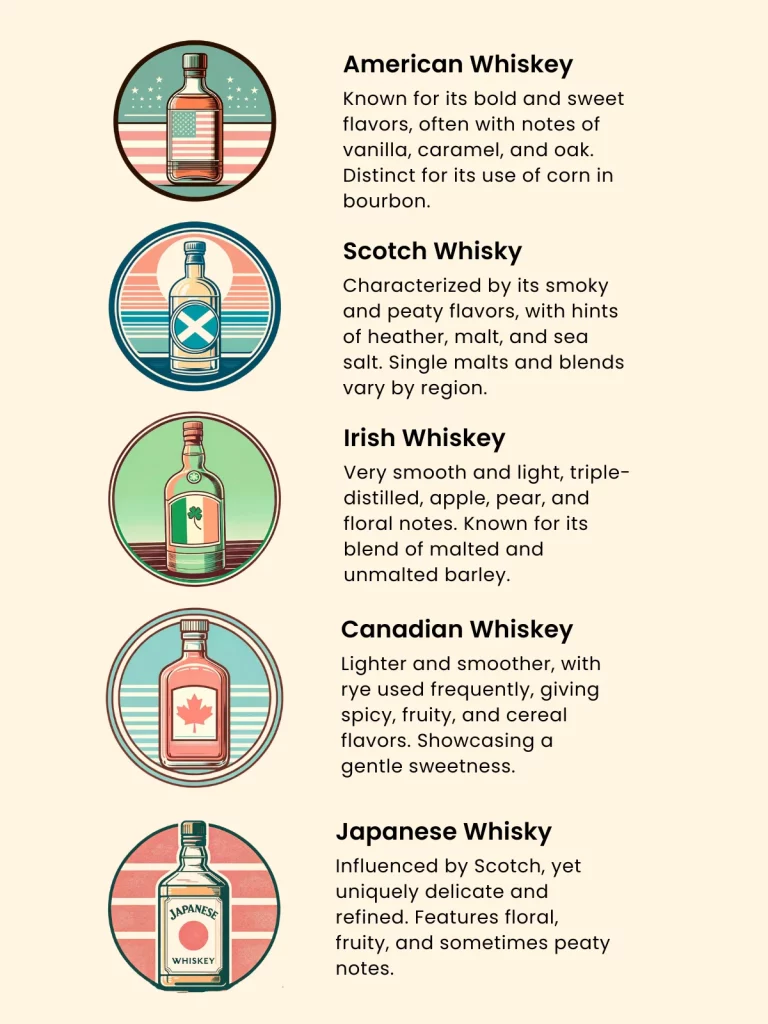
Irish Whiskey vs Canadian Whisky
Irish Whiskey and Canadian Whisky stand apart in their approach to whiskey making. Irish Whiskey’s hallmark is its triple distillation and predominant use of malted barley, which imbues it with a smooth, rich flavor. In contrast, Canadian Whisky often features a blend of grains, leading to a lighter, more versatile flavor profile that shines in mixed drinks.
Irish Whiskey vs American Whiskey
When comparing Irish Whiskey to American Whiskey, especially Bourbon, the distinction in sweetness and smoothness becomes apparent. American Whiskey’s higher corn content and aging in new oak barrels contribute to a pronounced sweetness. Conversely, Irish Whiskey is celebrated for its unparalleled smoothness and nuanced flavors, achieved through triple distillation and the use of unpeated malt.
Irish Whiskey vs Japanese Whisky
Irish Whiskey and Japanese Whisky both reflect a deep commitment to quality, yet they diverge in flavor and style. Japanese Whisky, with its Scottish-inspired techniques, tends towards a clean and refined taste. Irish Whiskey, however, is noted for its lighter, fruitier character, a result of its triple distillation process and unpeated malt, distinguishing it from the meticulously crafted Japanese variants.
Irish Whiskey vs Scotch Whiskey
The key difference between Irish Whiskey and Scotch Whisky lies in their use of peat and distillation practices. Scotch Whisky is famous for its distinct peaty and smoky flavors, a direct result of its production technique. Irish Whiskey, avoiding peat, offers a smoother and more accessible flavor, making it a gentler entry point into the diverse world of whiskey, highlighting the unique charm of each spirit.

